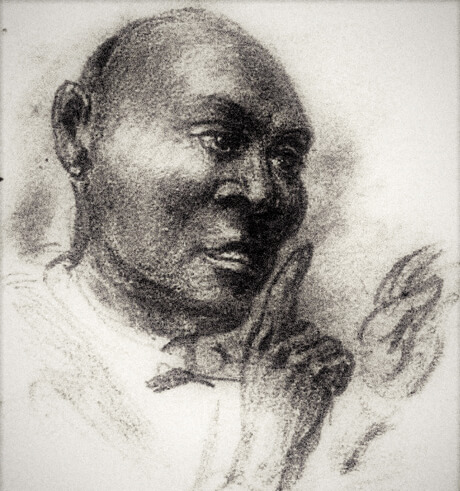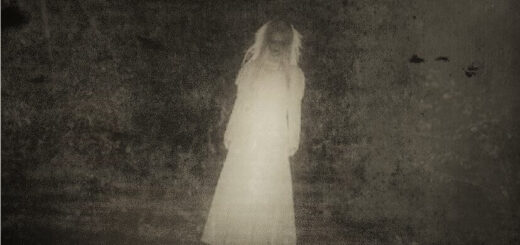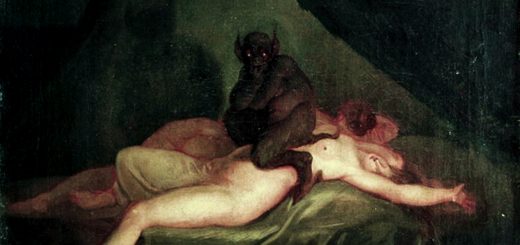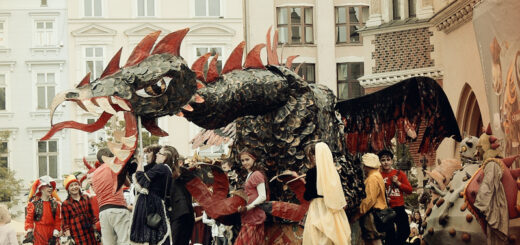Doctor John (Jean Montenee, Jean Montanet) – the original New Orleans Voodoo King
Doctor John (Senegal 1803 – New Orleans 1885) was a legendary Voodoo King in New Orleans. He was known by many other names, such as Prince John, Jean Montaigne, Jean Montenee or Jean Montanet, Jean La Ficelle, Jean Latanié, Jean Racine, Jean Grisgris, Jean Macaque, Jean Bayou, Voudoo John and Bayou John. In the Harper’s weekly of November 7th, 1885
Lafcadio Hearn described him as “The Last of the Voudoos“: “…he was the last really important figure of a long line of wizards or witches whose African titles were recognized, and who exercised an influence over the colored population. Swarthy occultists will doubtless continue to elect their “queens” and high-priests through years to come, but the influence of the public school is gradually dissipating all faith in witchcraft, and no black hierophant now remains capable of manifesting such mystic knowledge or of inspiring such respect as Voudoo John exhibited and compelled.“

Bayou Road, the oldest road of New Orleans, was once the location of the “Last of the Voudoos”, Doctor John.
His early years
Originally he was a native of Senegal, a free-born Bambara, or at least a member of some free tribe allied to the Bambaras, and claimed to have been a prince’s son, in proof of which he was wont to call attention to a number of parallel scars on his cheek, extending in curves from the edge of either temple to the corner of the lips. He was of middle height, very strongly built, with broad shoulders, well-developed muscles, an inky black skin, retreating forehead, small bright eyes, a very flat nose, and a woolly beard, gray only during the last few years of his long life. He had a resonant voice and a very authoritative manner.
At an early age he was kidnapped by Spanish slavers, who sold him at some Spanish port, whence he was ultimately shipped to Cuba. His West-Indian master taught him to be an excellent cook, ultimately became attached to him, and made him a present of his freedom. Jean soon afterward engaged on some Spanish vessel as ship’s cook, and in the exercise of this calling voyaged considerably in both hemispheres. Finally tiring of the sea, he left his ship at New Orleans, and began life on shore as a cotton-roller.
His physical strength gave him considerable advantage above his fellow-blacks; and his employers also discovered that he wielded some peculiar occult influence over his coworkers, which made him valuable as an overseer or gang leader. Jean, in short, possessed the mysterious obi power, the existence of which has been recognized in most slave-holding communities, and with which many a West-Indian planter has been compelled by force of circumstances to effect a compromise. Accordingly Jean was permitted many liberties which other blacks, although free, would never have presumed to take. Soon it became rumored that he was a seer of no small powers, and that he could tell the future by the marks upon bales of cotton.

The only existing image of Doctor John or Jean Montenee.
Settling in New Orleans
Doctor John claimed he was a prince in his homeland of Senegal who had brought the knowledge of Vodou from his home country Senegal. He joined an already prominent Vodou community that existed in New Orleans since the early 1700s developed by African slave groups such as the Bambara, Mandinga, Wolof, Ewe, Fulbe, Nard, Mina, Fon (Dahomean), Yoruba (Nago), Chamba, Congo, Ibo, Ado, Hausa, and Sango (Hall). Previous natives of Senegal were already enslaved in New Orleans by 1720.
Doctor John became so successful in the exercise of it that thousands of colored people flocked to him for predictions and counsel, and even white people, moved by curiosity or by doubt, paid him to prophesy for them. Finally he became wealthy enough to abandon the levee and purchase a large tract of property on the Bayou Road, where he built a house. His land extended from Prieur Street on the Bayou Road as far as Roman.
He bought female slaves and married several of them, performing his own ceremonies. Jean declared them his legitimate spouses according to African ritual, eventually claiming to have 15 wives and more than 50 children. The citizens of New Orleans stared at him in public, for he rode in a carriage with horses as fine as any white man. When Doctor John rode horseback alone, he wore a gaudy Spanish costume. Later he affected an austere black costume with a white, frilly shirt and grew a beard.
Fortune telling, magic and showers of stones
Leaving the Vodou-meetings to the administration of the Vodou-queens, Doctor John specialized in fortune-telling, healing and making gris-gris bags. At his new home Jean continued the practice of fortune-telling, but combined it with the profession of creole medicine, and of arts still more mysterious. By-and-by his reputation became so great that he was able to demand and obtain immense fees.
People of both races and both sexes thronged to see him–many coming even from far-away creole towns in the parishes, and well-dressed women, closely veiled, often knocked at his door. Parties paid from ten to twenty dollars for advice, for herb medicines, for recipes to make the hair grow, for cataplasms supposed to possess mysterious virtues, but really made with scraps of shoe-leather triturated into paste, for advice what ticket to buy in the Havana Lottery, for aid to recover stolen goods, for love powers, for counsel in family troubles, for charms by which to obtain revenge upon an enemy. Once Jean received a fee of fifty dollars for a potion. “It was water,” he said to a creole confidant, “with some common herbs boiled in it. I hurt nobody; but if folks want to give me fifty dollars, I take the fifty dollars every time!”
One of Doctor John’s specialties was the starting or stopping of poltergeist phenomena, usually showers of rocks and stones on the victim’s home. Something called lithoboly in parapsychology and cases of stone showers have been reported throughout history, especially in connection to cases of witchcraft and demonic possession. Policemen stood baffled as the rocks rained down, apparently from nowhere. Naturally, Doctor John could stop such harassment, for a fee. One case reports that the slaves of a Samuel Wilson paid 62 dollars to stop a shower of rocks, but Wilson took Doctor John to court to retrieve the 62 dollars. A few days later, the rock showers began again.

Detail of New Orleans Voodoo or Vodou-altar.
Doctor John’s office
His house was filled with snakes, lizards, toads, scorpions and human skulls stolen from graveyards and his office furniture consisted of a table, a chair, a picture of the Virgin Mary, an elephant’s tusk, some shells which he said were African shells and enabled him to read the future, and a pack of cards in each of which a small hole had been burned.
About his person he always carried two small bones wrapped around with a black string, which bones he really appeared to revere as fetiches. Wax candles were burned during his performances; and as he bought a whole box of them every few days during “flush times,” one can imagine how large the number of his clients must have been. They poured money into his hands so generously that he became worth at least $50,000!

Modern street view of Bayou Road
Healing and charity
Through Doctor John’s work in the medicinal aspects of Voodoo, he gained a reputation for being an excellent healer. Some reports went as far to state that he had the ability to resuscitate patients on the verge of death through his rituals. On grand occasions John used to distribute largess among the colored population of his neighborhood in the shape of food–bowls of gombo or dishes of jimbalaya.
He did it for popularity’s sake in those days, perhaps; but in after-years, during the great epidemics, he did it for charity, even when so much reduced in circumstances that he was himself obliged to cook the food to be given away. Even at the end of his life, when he had lost his fortune he used his skills to heal.
Testimony to his remarkable skill in the use of herbs could be gathered from nearly every one now living who became well acquainted with him. During the epidemic of 1878, which uprooted the old belief in the total immunity of West Aficans and colored people from yellow fever, two of Jean’s children were “taken down.” “I have no money,” he said, “but I can cure my children,” which he proceeded to do with the aid of some weeds plucked from the edge of the Prieur Street gutters. One of the herbs, I am told, was what our creoles call the “parasol.” “The children were playing on the banquette next day,” said my informant.

The fatal Signature of Doctor John
Victim of fraud and gambling addiction
Unable to read or write, Doctor John amassed a fortune, but by the end of his life he became the victim of a con artist, who had him sign his name on a contract by which he lost all his Bayou Road property. He did not know what to do with his money. He had no faith in banks, and had seen too much of the darker side of life to have much faith in human nature.
For many years he kept his money under-ground, burying or taking it up at night only, occasionally concealing large sums so well that he could never find them again himself; and now, after many years, people still believe there are treasures entombed somewhere in the neighborhood of Prieur Street and Bayou Road.
All business negotiations of a serious character caused him much worry, and as he found many willing to take advantage of his ignorance, he probably felt small remorse for certain questionable actions of his own. He was notoriously bad pay, and part of his property was seized at last to cover a debt. Then, in an evil hour, he asked a man without scruples to teach him how to write, believing that financial misfortunes were mostly due to ignorance of the alphabet. After he had learned to write his name, he was innocent enough one day to place his signature by request at the bottom of a blank sheet of paper, and, lo! his real estate passed from his possession in some horribly mysterious way.
Still he had some money left, and made heroic efforts to retrieve his fortunes. He bought other property, and he invested desperately in lottery tickets. The lottery craze finally came upon him, and had far more to do with his ultimate ruin than his losses in the grocery, the shoemaker’s shop, and other establishments into which he had put several thousand dollars as the silent partner of people who cheated him.
Though at the time his protegee, the famous Voodoo Queen Marie Laveau, succeeded by her daughter of the same name had taken over the New Oleans Vodou-business, he might certainly have continued to make a good living, since people still sent for him to cure them with his herbs, or went to see him to have their fortunes told; but all his earnings were wasted in tempting fortune.
At age 80, after a score of seizures and a long succession of evictions, he was at last obliged to move in with children from his white wife, though he despised mulattoes. All he had once owned nothing remained to him but his African shells, his elephant’s tusk, and the sewing-machine table that had served him to tell fortunes and to burn wax candles upon. New Orleanians gossiped that Doctor John was “fixed,” and the victim of spells greater than his. Four years after the death of his pupil Marie Laveau, he died in August 1885 at age 82.
You may also like to read:
The Seven Nachons or Loa Families in Vodou
New Orleans superstitions
Voodoo
Pomba Giras and Exu’s
Mami Wata
Palo, Hoodoo
Santeria, Umbanda, Vodum
Sanite dede Regina Nicaud
Datura stramonium – Jimson weed






